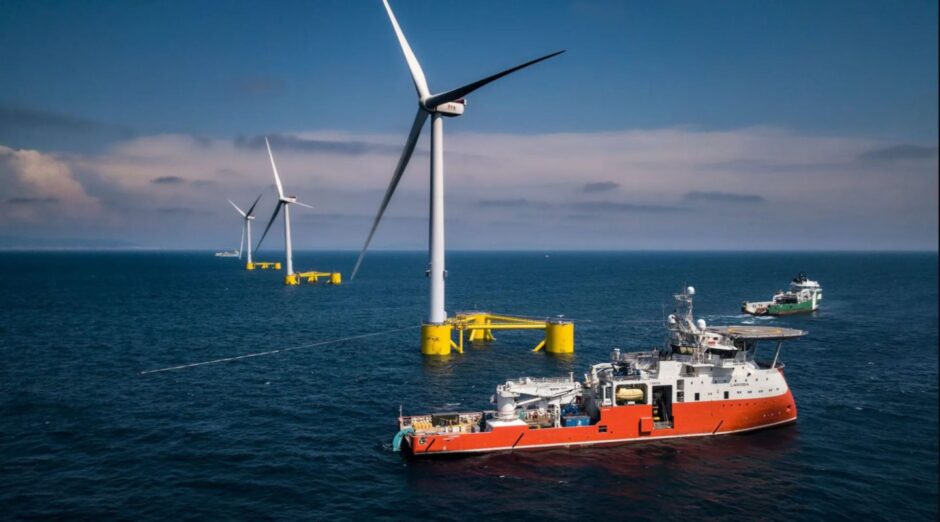
As a famously windy island nation and an early adopter of the technology, it’s easy to take offshore wind power for granted in the UK.
But as the sector matures, dozens of nations are now examining how to harness those gains and how to best to exploit their own resources.
Amongst the groups helping them is Xodus, which is increasingly looking to ‘origination’ – advising governments and potential bidders on how those markets could develop.
Global offshore renewables director Jamie MacDonald says the UK, US, Japan, Australia are its “primary markets”, but each of those larger regions, including Middle East and Africa (MENA), Americas and APAC all have ambitions to be emerging offshore wind markets.
In the UK and Europe, new interest is focused mainly in places like Portugal, Spain, Greece, Finland, Sweden and Norway, he suggests. But Xodus’ Americas team are also supporting work in Canada, Brazil and Colombia, while Asia Pacific staff are concentrated in Australia, while keeping eyes on New Zealand, the Philippines and most recently, India.
So what attracts developers and their advisors to a particular market?
Mr MacDonald says there are three main criteria that firms will want to see out of the government in order to give them confidence. The first is a route to market; countries must have a stable system where power offtake can be sold – and at a price that makes projects investible.
The second is grid. Potential project owners will want to understand any constraints, and ultimately how easy it will be for them to export electrons onto the grid.
Finally, they will consider the environmental permitting and consenting regime, and how robust and/or efficient this will be.
There are additional factors such as collecting good wind speed data, or a sound understanding of stakeholder engagement – something usually familiar to countries who have oil and gas leasing processes as well.
“Those are added bonuses, but it’s really the trifecta of route to market, environment and grid. If you if you can nail that piece as a government, then you’ve got a quite attractive market,” he says.
Areas of interest
Within those broad criteria however, every region is different.
“Turkey is a good example – their first offshore wind auction round didn’t attract any interest. This was several years ago, and so they’re now going through a process of: ‘How do we make Turkish offshore more attractive to external investors’?”
Mr MacDonald says political uncertainty remains an issue here, as does the strength of the local lira. In response however, local authorities are considering additional factors that can help de-risk the market, including deploying wind measurement buoys and designing a more attractive auction model.
At the more frontier stages, he points to new momentum off Japan, which has just moved to expand its leasing processes beyond territorial waters and into the much larger exclusive economic zone (EEZ), potentially providing up to ten times more leasing space. The government intends to reach 10GW of offshore capacity by 2030, and potentially up to 45GW by 2040.
In India too the government recently invited bids to build projects across four 1-GW blocks off the coast of Tamil Nadu, with bid submissions due in early May. A further three areas are set to be leased in 2025.
“That’s a big move forward for that market, which has been on the periphery for a while now,” he remarked.
In Western Europe, he says Portugal is a “really interesting” emerging player.
“They’ve really demonstrated a strong commitment to try and get 10GW on the grid by 2030.
“We’ve seen significant interest from global energy companies, smaller ’boutique’ developers all the way up to multinational oil and gas majors register interest there.”
Indeed in November 2023, some 50 companies and consortia expressed interest in bidding in its first auction, a process which will see three areas – Viana do Castelo (1 GW), Leixões (500 MW), and Figueira da Foz (2 GW) – shortly open for tender.
The list includes major renewables players such as Iberdrola, RWE and Corio, through to oil and gas majors like Equinor, TotalEnergies, GALP and Repsol, as well as local ventures.
Across the Atlantic in Brazil, ambitions from both government and potential developers are high. Brazil’s federal energy research office suggests installed capacity could reach around 16GW by 2050, but as of last summer some 189GW worth of projects have initiated the licensing process.
Mr MacDonald suggests the present stage amounts to something of “a massive land grab”, but the overlapping nature of many of the projects certainly means a fraction of this capacity will proceed.
“It will be interesting to see how Brazil structures their auction for those sites going forward, because they’ve not defined the sites, they’ve not defined what the auction process is going to be or when it’s going to be. So there’s still a bit of uncertainty around there.”
Nevertheless, as in Portugal, there is strong interest from a cross section of potential developers – particularly given the existing oil and gas supply chain.
“Equinor from an oil and gas perspective are very comfortable in the Brazilian market” he notes. “So it’s a fairly straightforward step for them to make and you’ve seen big commitments from them.”
“I believe Petrobras has said when it comes around they are interested in supporting or being part of the offshore wind market.”
Indeed, the two will also work together under an MoU signed last year which will see them assess the potential to build up to seven projects, with a combined 14.5GW.
And in December, Colombia launched its first offshore wind auction, as part a process expected to procure around 3GW of capacity. Around 12,000 sq km are on offer in the Atlántico, Bolívar and part of Sucre and Magdalena departments, with the process expected to conclude this autumn.
Competing on more than cost
Part of the reason for the broad interest seen in many of these markets is that many of the leasing and auction criteria have yet to be defined. Increasingly though, governments and licensors – the UK included – are opting for additional criteria beyond who is prepared to bid the most to secure acreage.
“Because at the moment there is no definition in what the auction process is, all the more independent players and local JVs or onshore developers are interested – because they see this might not be a “deepest pockets” market, and therefore they can participate.
“That’s why you’re seeing that breadth interest. It’s the same with Canada, and with Portugal.”
That process is already seen in the prequalified bidders for Norway’s first floating wind bidding round at Utsira Nord. Mr MacDonald said a range of different organisations are participating largely because the auction is criteria-based and “a little bit more qualitative rather than quantitative”, encouraging more interest.
But exactly what commitments can be made to local content – and what exactly should be done where, is a question that needs answered by the sector “sooner rather than later”, he says.
“A lot of these new frontier markets are going to need a certain amount of investment in infrastructure to be able do the construction and operation.
“The extent to which supply chain elements, such as nacelles, blades, cables, or monopiles, are sourced from that country will largely depend on the local content requirements established by the government
“It won’t make or break the industry, but it will definitely shift the economics of projects and ultimately the cost of electricity. Finding the balance of fostering industry development and economic growth by encouraging investment in local capabilities against the increased CAPEX costs this will bring, is key.”
Some pragmatism from all sides will likely be needed to see many of these procedures through.
In the doldrums
There are some notable omissions amongst these areas of interest too – particularly in the Middle East and Africa where offshore wind is likely to remain a longer-term proposition. In part this is due to more abundant, cheaper onshore wind and solar resources, but also larger challenges around energy access and infrastructure across much of the African continent.
“In terms of Africa, most of the development we’re seeing is in the European side of the Med,” says Mr MacDonald. “We’ve seen hints that South Africa might look at offshore wind but not much beyond that.
“There’s been some talk around offshore wind to support isolated coastal communities, that type of deployment, but it would be smaller scale.”
In the Middle East there are plans to progress some floating wind assets in the Red Sea, but these too are likely to pale in comparison to other resources.
But he also cautions that we should not let frontier aspirations get too carried away.
“Frontier markets are exciting and they’re going to be key to unlocking [more renewable energy].
“But let’s not forget that there’s still a huge growth opportunity in the UK and other established markets in Europe. We really want to see government setting those ambitious goals and maximising this summer’s auction.”
The numbers speak for themselves; the UK will need to award 20-22GW in allocation rounds (AR) 6 and 7 if 2030 goals are to be met.
“The chance of awarding at least 10GW but possibly up to 14.9GW in this AR6 auction if all potential eligible projects chose to participate – that’s a massive step forward.”
Recommended for you

 © Supplied by Xodus
© Supplied by Xodus © Supplied by Equinor
© Supplied by Equinor